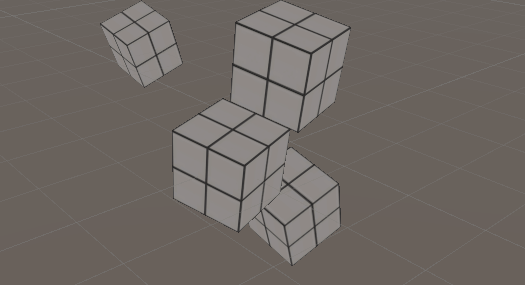概述
本文主要是针对《3D数学基础-图形与游戏开发》这本书的读书笔记,这本书前面部分还是讲得挺好的,有时间还是建议读一下。
旋转矩阵的推导
旋转矩阵怎么来的我倒一直都没有概念,这本书里面对旋转矩阵的来历倒是给了我一些启发。
首先从二维的旋转矩阵开始
推导的方式就是直接找点代入:
想象点(1,0),绕原点逆时针旋转
,我们把(1,0)和旋转矩阵相乘,得到的就是旋转矩阵第一行的信息,那显然,第一行就是
,同理,代入(0,1)到旋转矩阵也能得到旋转矩阵第二行的值。

不得不承认,这个pdf里面截的图要把人看瞎了,但是问题不大,大概是什么意思还是能明白的。
对于三维旋转绕坐标轴旋转的矩阵来说,推导也是同理的,代入相关的点的坐标即可,图书里面有,但是pdf特别糊,就不截了。也可以理解为三维坐标系投影到二维中,然后运用二维的旋转矩阵公式。
下面就是绕x轴的旋转矩阵,可以理解为在YOZ平面进行旋转,这样的话直接代入上面的二维的公式也行。
对于绕y轴和z轴的矩阵的由来就不再赘述了。
绕任意轴的旋转矩阵
这个推导看起来还是很复杂的,为了后面四元数部分的理解,这个推导还是有必要看一下的!
我们假设旋转轴通过原点,用单位向量n来描述这个旋转轴,用
来描述旋转的角度。我们只需要用n和
就可以推导出来最后的旋转矩阵。
实际的推导我们只需要通过书里面一张图就很容易去理解了
电子版的图太糊了,我画图简单的山寨了一份。

交代一下背景,v绕着n旋转
v∥是v在n上的投影,v∥=(v* n)n,v* n等于投影长度,乘上方向的单位矩阵n,也就得到了最后的v∥
v⊥是垂直于v∥的分量,有v⊥=v-v∥ = v-(v* n)n
w是垂直于v∥和v⊥的分量,长度等于v⊥,w=n x v⊥
然后书上就来了v⊥’=v⊥cosθ+wsinθ,这个一开始我还是不是很理解的,后来我把旋转的那个投影到平面上,也就是如下图所示,因为是旋转,所以v⊥’的长度一定是等于v⊥的,当然也等于w,所以如下图所示,投影到两个坐标轴上面,于是就有了上面的公式。

在知道了v⊥’的情况下,最后的v’值就是v∥+v⊥’
代入所有的值,就有v’ = (v-(v* n)n)cosθ+(nxv)sinθ+(v* n)n
那么我们知道了坐标变换,该如何去得到变换矩阵呢,这又回到了我们前面提到的思路,分别代入[1,0,0],[0,1,0],[0,0,1]点到变换公式中,得到的三个向量分别作为矩阵的三行就行了,最后的旋转矩阵如下所示:
markdown输入矩阵挺爽的。。。。
在unity实现
基本思路就是给定一条直线,比如说x=y,然后把基于x=y的旋转矩阵实时传入着色器,让物体随着时间能绕着x=y进行旋转。

脚本很简单,里面包括了我们之前推导的旋转矩阵,不过值的注意的点是,记得把方向归一化,这个问题我找了好长时间才发现。
using System.Collections;
using System.Collections.Generic;
using UnityEngine;
public class RotateMatrixTest : MonoBehaviour
{
public float speed;
public Material mat;
public Vector3 n;
public float currentTheta;
private Matrix4x4 calculateRotateMatrix(Vector3 n,float theta)
{
Matrix4x4 RotationMatrix = new Matrix4x4();
RotationMatrix[0, 0] = n.x * n.x * (1 - Mathf.Cos(theta)) + Mathf.Cos(theta);
RotationMatrix[0, 1] = n.x * n.y * (1 - Mathf.Cos(theta)) + n.z * Mathf.Sin(theta);
RotationMatrix[0, 2] = n.x * n.z * (1 - Mathf.Cos(theta)) - n.y * Mathf.Sin(theta);
RotationMatrix[0, 3] = 0;
RotationMatrix[1, 0] = n.x * n.y * (1 - Mathf.Cos(theta)) - n.z * Mathf.Sin(theta);
RotationMatrix[1, 1] = n.y * n.y * (1 - Mathf.Cos(theta)) + Mathf.Cos(theta);
RotationMatrix[1, 2] = n.y * n.z * (1 - Mathf.Cos(theta)) + n.x * Mathf.Sin(theta);
RotationMatrix[1, 3] = 0;
RotationMatrix[2, 0] = n.x * n.z * (1 - Mathf.Cos(theta)) + n.y * Mathf.Sin(theta);
RotationMatrix[2, 1] = n.y * n.z * (1 - Mathf.Cos(theta)) - n.x * Mathf.Sin(theta);
RotationMatrix[2, 2] = n.z * n.z * (1 - Mathf.Cos(theta)) + Mathf.Cos(theta);
RotationMatrix[2, 3] = 0;
RotationMatrix[3, 0] = 0;
RotationMatrix[3, 1] = 0;
RotationMatrix[3, 2] = 0;
RotationMatrix[3, 3] = 1;
return RotationMatrix;
}
private void Update()
{
Vector3 normalizedN = n.normalized;
currentTheta += speed;
if (currentTheta > 360 || currentTheta < -360)
currentTheta = 0;
mat.SetMatrix("_RotationMatrix", calculateRotateMatrix(normalizedN, Mathf.Deg2Rad*currentTheta));
}
}
着色器代码如下(我们是绕着模型空间来旋转的):
Shader "Unlit/rotateTest"
{
Properties
{
_MainTex ("Texture", 2D) = "white" {}
}
SubShader
{
Tags { "RenderType"="Opaque" }
Pass
{
CGPROGRAM
#pragma vertex vert
#pragma fragment frag
#include "UnityCG.cginc"
struct appdata
{
float4 vertex : POSITION;
float2 uv : TEXCOORD0;
};
struct v2f
{
float2 uv : TEXCOORD0;
float4 vertex : SV_POSITION;
float4 worldPos : TEXCOORD1;
};
sampler2D _MainTex;
float4 _MainTex_ST;
float4x4 _RotationMatrix;
v2f vert (appdata v)
{
v2f o;
fixed4 rotPos = mul(_RotationMatrix,v.vertex);
o.vertex = UnityObjectToClipPos(rotPos);
o.uv = TRANSFORM_TEX(v.uv, _MainTex);
return o;
}
fixed4 frag (v2f i) : SV_Target
{
// sample the texture
fixed4 col = tex2D(_MainTex, i.uv);
return col;
}
ENDCG
}
}
}
